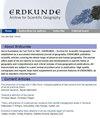缅甸仰光家庭的灾害风险意识和备灾能力:灾害经验、社会人口因素和空间差异
IF 1.1
4区 社会学
Q3 GEOGRAPHY
引用次数: 0
摘要
在灾害频发的国家,整个社会以及家庭和个人都应尽可能提高抗灾能力,这一点备受关注。在缅甸,洪水、龙卷风和干旱等自然灾害频发,地震发生的概率也很高,因此,为了提高社会、家庭和个人的抗灾能力,提高对灾害的认识并做好备灾工作就显得尤为重要。灾害研究表明,人们对灾害的认识和感知,以及他们对风险的防备程度会有很大差异。这似乎有多方面的原因:家庭和人们的社会人口特征以及以前的灾害经历似乎起着至关重要的作用。了解这些变量的信息,并理解它们如何影响家庭和人们的灾害风险意识和备灾能力,可以为提高个人的灾害风险意识和备灾能力提供一个重要的背景,最终目的是提高社会、家庭和个人的抗灾能力。本文介绍了在仰光(缅甸)八个乡镇开展的家庭调查的结果。分析调查了仰光市不同地区受访者及其家庭的社会人口特征和以往的灾害经历如何影响他们的灾害风险感知和备灾能力。结果表明,仰光市不同地区的社会人口特征和以往的灾害经验对灾害风险感知和备灾能力的影响存在很大差异。最后,研究结果为成功的灾害管理提供了参考和信息。本文章由计算机程序翻译,如有差异,请以英文原文为准。
Disaster risk perception and preparedness of households in Yangon, Myanmar: Disaster experiences, socio-demographic factors and spatial variation
In disaster-prone countries, it is of great concern that societies as a whole, as well as households and individuals, should become as resilient to disasters as possible. In Myanmar, with its frequent natural hazards like floods, cyclones and droughts and its high probability of earthquakes, raising awareness of and preparedness for disasters is of eminent importance in order to increase the resilience of society, households and individuals. Disaster research shows that the awareness and perception of people regarding disasters and thus also their risk preparedness can vary substantially. This seems to stem from various sources: the socio-demographic characteristics of households and people as well as former experiences of disaster seem to play a crucial role. Information of such variables and understanding how they influence the disaster risk perception and preparedness of households and people can provide an important background against which to improve individual disaster risk awareness and preparedness – with the final aim of making society, households and individuals more resilient. In this paper, the results of a household survey carried out in eight townships of Yangon (Myanmar) are presented. The analysis investigates how socio-demographic characteristics and the previous experiences of disaster of the respondents and their households influence their disaster risk perception and preparedness in different areas of Yangon City. The results show strong differences in disaster risk perception and preparedness according to socio-demographic characteristics and previous experiences of disaster in different areas of Yangon City. Finally, the findings feed into and inform about successful disaster management.
求助全文
通过发布文献求助,成功后即可免费获取论文全文。
去求助
来源期刊

Erdkunde
地学-自然地理
CiteScore
2.00
自引率
7.10%
发文量
17
审稿时长
>12 weeks
期刊介绍:
Since foundation by Carl Troll in 1947, ''ERDKUNDE – Archive for Scientific Geography'' has established as a successful international journal of geography. ERDKUNDE publishes scientific articles covering the whole range of physical and human geography. The journal offers state of the art reports on recent trends and developments in specific fields of geography and comprehensive and critical reviews of new geographical publications. All manuscripts are subject to a peer-review procedure prior to publication. High quality cartography and regular large sized supplements are prominent features of ERDKUNDE, as well as standard coloured figures.
 求助内容:
求助内容: 应助结果提醒方式:
应助结果提醒方式:


